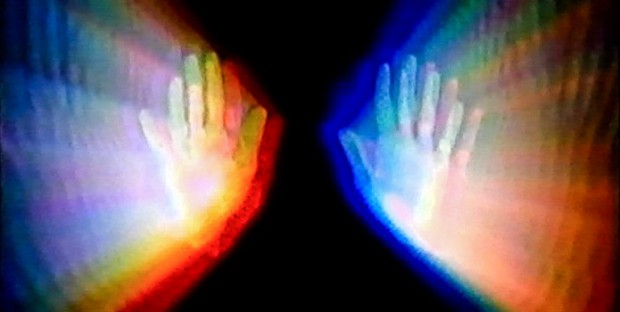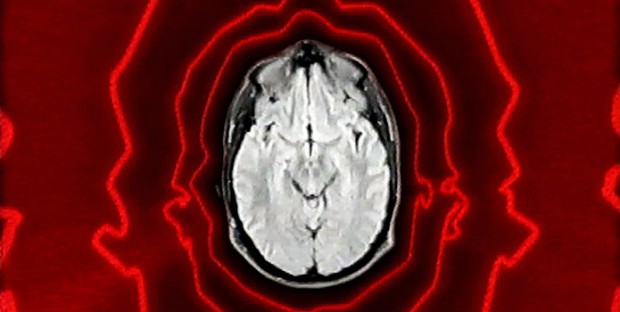![]()
We Went to Toronto: Cronenberg and Bowie
by PADDY JOHNSON AND CORINNA KIRSCH on NOVEMBER 27, 2013

Jeremy Shaw, Introduction to the Memory Personality
David Cronenberg: Transformation: Candice Breitz, James Coupe, Marcel Dzama, Jeremy Shaw, Jamie Shovlin, Laurel Woodcock
Through Dec 29, 2013
Museum of Contemporary Canadian Art (MOCCA), organized by MOCCA and the Toronto International Film Festival
What’s on view: Six artists were given the task of creating art inspired by the distinctive Canadian film director
Corinna Kirsch: I was surprised that so many of the works that were asked to “respond” to Cronenberg ended up borrowing from the director’s films: Candace Breitz used footage from The Brood; Laurel Woodcock adhered vinyl lettering with words from Cronenberg’s films; and Marcel Dzama paid homage Cronenberg’s most memorable scenes—the ones that get scratched into your brain like the monstrous births, forced TV watching, and heads exploding—by showing similar events in his own film, A Jester’s Dance. Maybe that’s a sign of distinction. Cronenberg’s films are too one-of-a-kind; you can’t be Cronenberg-like without seeming derivative.
I wonder, could there be no such thing as a painting that’s Cronenberg-like? (In this exhibition, the response is the sound of crickets.)

James Coupe's Swarm
There were a few works that weren’t derivative. James Coupe’s Swarm, an installation of 16 flatscreen monitors lined up overhead into a square shape, held up by a series of poles. A wall-label noted you’d be filmed, too. The monitors showed what looked like an earlier crowd of people gathered at MOCCA, and as you walked around the square, the crowds changed. Some of the monitors were empty, but you never saw yourself. I assume we were being recorded as raw footage for later visitors, but I don’t know. After all, how functional can surveillance be if the watchers’ purposes are known? Anyway, maybe I’m setting the bar low here, but I was pleased this work wasn’t plastered all-over with “Cronenberg.”
Paddy: Given the perameters of the show I’m not sure it’s fair to call the work derivative, though we can certainly say that the approach didn’t yield the results one might hope for given the “assignment” feel to the show. Honestly, I think it’s hard to evoke the terror Cronenberg produces in a movie theatre designed for 90-minutes-plus of movie watching in a gallery space designed for much shorter term viewing and transformative experience. They are almost inherently safe places.
With Coupe, I rather liked that the motion detector that flicked your image off the screen and onto another wasn’t hidden. It was attached to the pole of TVs and a light went off whenever it recognized a body. I read that as a message about surveillance—it doesn’t have to bother hiding—and I guess that’s the case, because apparently the piece uses social media algorithms to group visitors. Presumably, at some point, we too are integrated into these groups on the screen.
What it tells us about social media is a little murky, imo, because it’s not using any of the information that makes media social; it doesn’t know my friends, my interests, my buying behavior and I wouldn’t freely offer it if asked. So what exactly is it evaluating to make these groups? And what is it telling me about how it functions? I wish it were more.
Corinna: You’re right; if it tells us anything about social media, it’s that we don’t know how we’re being “used” by it.

Jeremy Shaw, Introduction to the Memory Personality
Paddy: Overall, Jeremy Shaw’s video, “Introduction to The Memory Personality” had the most to say and oddly enough, it was the easiest to miss in its location beside the front desk, and outside the exhibition. “It doesn’t matter what you forget. Your subconscious will remember what your conscious mind will remember it has forgotten,” says a voice over a hallway before a flash of black interupts the viewed image. *Blink*. The hall image shifts slightly. *Blink* The voice now talks over a sunset. *Blink* The image erodes, *Blink* and erodes.
I wrote all this down, as I watched it, assuming both my subconscious and conscious mind would forget the video (I’m afflicted with a terrible memory…or am I???).
Corinna: Nope. I did the same, and wrote down most of what the narrator said. Maybe it has to do with how all that repetition evokes rote, secondary-school memorization? But of course that saying “It doesn’t matter what you forget. Your subconscious will remember what your conscious mind will remember it has forgotten” made me feel a little better about my futility.
Paddy: More than that ominous voice, though, we then see a collage of spooky images, a data stream the resembles the matrix, epilepsy evoking image changes, a CD and a deep voice styled from the 90’s saying “Remember dancing? Remember not sleeping? and time becomes a loop…”
It felt like I was living an episode of the X-Files, and was willing to participate in the idea that my mind might get hijacked.
Let your conscious mind stay relaxed.
Do your past failures still bother you?
Does life seem vague and unreal to you?
You are aware of everything.
No need for awareness.
By the time the piece was through, I was wanting my mind hijacked. There was a very Matrix moment in the film, except you chose the reprogramming pill rather than awareness. In 2013, somehow that seemed like a good option.